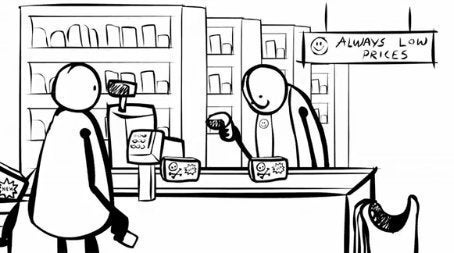
As a mother, I want to be sure that the shampoo, sunscreen, bubble bath and other personal care products my daughter uses are safe. If I stick to products in the children's aisle at the drugstore -- stuff that's made and marketed specifically for kids -- those should be OK, right?
The labels are reassuring: "Gentle." "Pure." "Natural." "Free of Harsh Ingredients." "Recommended by Pediatricians." "Dermatologists Approved." And of course, "No More Tears."
But when you turn the bottles around, get out a magnifying glass and read the fine print on the back (and get online to do some research) it's a different story: sodium laureth sulfate, diazolidinyl urea, ceteareth-20, PEGs, quaternium-15 -- all these are typically contaminated with cancer-causing chemicals like formaldehyde or 1,4 dioxane.
Carcinogens in baby shampoo? Are you kidding me?
I asked some scientists what was going on, and what they told me was scary, and not just for our children. It turns out the average American bathroom is a minefield of toxic chemicals. Sunscreens, lipstick, moisturizer, shaving cream -- many cosmetics and personal care products for babies, kids, moms and dads contain chemicals linked to cancer or other health problems like learning disabilities, asthma and even damaged sperm.
I got so mad about this I joined with the Campaign for Safe Cosmetics to make a new video, The Story of Cosmetics.
It turns out that while you and I can choose to buy the safer products made by responsible companies, the really important decisions don't happen when we take a product off the shelf. What counts is when companies and government agencies decide what should be allowed on the shelves.
Here's just some of what I learned while making The Story of Cosmetics:
• All those sudsy products like shampoos and body washes that contain sodium laureth sulfate have as a byproduct 1,4-dioxane, a known carcinogen that's suspected to also cause kidney, nerve and respiratory problems. Unlike many other countries, the U.S. government does not limit formaldehyde, 1,4-dioxane, or most other hazardous substances in personal care products. As a result, independent lab tests found these chemicals in dozens of brands, including Johnson's Baby Shampoo and Sesame Street Bubble Bath. The companies claim that the chemical levels aren't large enough to worry about, but I'd prefer not to have any cancer-causing chemicals in my daughter's shampoo -- or mine.
• Protecting yourself from the sun shouldn't be dangerous. But a number of common sunscreen chemicals are linked to cancer, and may also disrupt estrogen and thyroid hormones. Well over half of all sunscreens contain the potential hormone disruptor oxybenzone that readily penetrates the skin and has been found in the bodies of 97% of Americans tested by the Centers for Disease Control.
• Dabbing on a little bit of lipstick seems harmless enough -- if you don't mind a little lead. Tests commissioned by the Campaign for Safe Cosmetics found lead in almost two-thirds of top-selling red lipsticks. Highest lead levels were in top-selling brands L'Oreal, Maybelline and Cover Girl. Lead, a proven neurotoxin for which there is no safe level of exposure for children, was also found in every brand of kids' face paints tested.
You'd think the government would be working to keep hazardous chemicals out of cosmetics. Think again. The Food and Drug Administration doesn't assess the safety of personal care products or their ingredients. Since the federal cosmetics law was written more than 70 years ago, the FDA has banned just eight out of the 12,000-plus ingredients used in cosmetics. The FDA doesn't even require all of the ingredients to be listed on the label.
Instead, the government lets the cosmetics industry set up its own committee to self-police its products -- and compliance with the committee's "recommendations" is voluntary. The cosmetics industry is making the rules and deciding whether or not to follow them.
Women, parents, workers, people all over the country are demanding that Congress overhaul the outdated cosmetics law to give the FDA the power to make sure that our personal care products are safe. And Congress has heard them.
Today, Reps. Jan Schakowsky (D-Ill.), Ed Markey (D-Mass.) and Tammy Baldwin (D-Wisc.) are introducing the Safe Cosmetics Act of 2010, which would close the gaping holes in federal law. It would phase out the most dangerous chemicals, set up a system to assess cosmetic ingredients for safety, require companies to be transparent about what's in their products, and provide adequate resources for the FDA to do its job. It will also help small businesses in the cosmetics industry meet the new regulations, while spurring the development of greener chemicals that will help companies compete for customers who value safety and openness.
As you can imagine, the personal care product industry isn't so excited about this. The big cosmetics companies have already spent millions of dollars trying to defeat real reforms and proposing meaningless alternatives. Only a major mobilization of everyone who is affected by this problem from across the political spectrum can provide the support to pass this landmark legislation. You can add your voice to the calls for reform here. Then pass The Story of Cosmetics around to family and friends.
Together, we can tell the industry it's time to come clean.
Annie Leonard is director of The Story of Stuff Project and author of The Story of Stuff: How Our Obsession with Stuff is Trashing the Planet, Our Communities and Our Health and A Vision for Change.